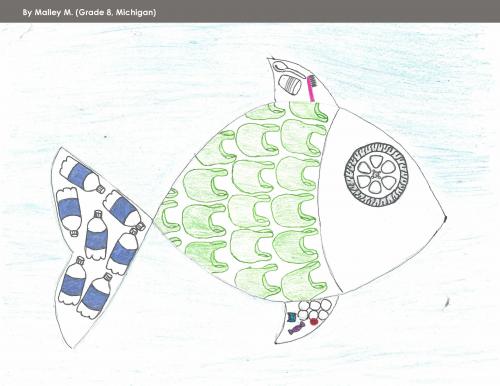NOAA Marine Debris Calendar celebrates student voices, student art
Alpena students bring a Great Lakes perspective to the global marine debris issue.

A new year is just around the corner – and it’s also an opportunity to celebrate a local youth leader who is featured in the national 2017 NOAA Marine Debris Calendar. This year’s calendar showcases the artwork of Malley M., a 2015-16 eighth-grade student at All Saints Catholic School in Alpena, Mich. Connected to that classroom’s efforts to raise awareness about plastic pollution in the Great Lakes, Malley’s art was chosen as one of twelve young artists contributing to the annual calendar. She not only created an imaginative, eye-catching piece of art for this competition, but she also applied her school skills in addressing this marine debris issue locally.
In her achievement, she represents her broader team of classmates, educators, school, and community. Her teacher, Alecia Deitz, engages students – through their learning – in environmental stewardship projects aimed at enhancing their local community. Supported by the Northeast Michigan Great Lakes Stewardship Initiative (NEMIGLSI) network, the All Saints School educator team explores local issues and community needs through a place-based stewardship education (PBSE) instructional process. Through this network, educators and students first investigated the issue of marine debris and plastic pollution in the Great Lakes – an issue commonly connected with our world’s ocean but sometimes forgotten about here locally in our Great Lakes.
Through the NEMIGLSI network, students connected with the Alliance for the Great Lakes, NOAA Thunder Bay National Marine Sanctuary, Michigan Sea Grant, Michigan State University Extension and Huron Pines AmeriCorps who support their efforts to raise awareness toward marine debris and plastic pollution. Place-based stewardship education is more than an art or science project – rather it reflects hands-on, student-engaged, and interdisciplinary learning experiences for students, educators, and their community. Malley’s artwork reflects an educational aspect of their project, and other All Saints student leaders across multiple grades also investigated this issue locally.
During the 2015-16 school year, students launched a marine debris and consumption investigation by watching Bag It: Is your life too plastic? Next seventh- and eight-graders completed cafeteria audits for single-use versus reusable plastics, and applying math, they calculated over 1,500 single-use items in their cafeteria. After collecting data, they hosted a schoolwide assembly, where they highlighted the impact of the marine debris on the environment and shared the collected weekly tally for single-use plastics. They challenged their school and classmates to reduce single-use plastics and offered alternatives like skipping straws or using reusable containers in trade for plastic sandwich bags. The following week, they tracked single-use plastics in their cafeteria again, and found a decrease to less than 900 single-use items! Cafeteria staff contributed also by switching from disposable to reusable silverware.
Expanding their work into the community, students presented their research during the Thunder Bay International Film Festival, setting up an educational table and presented as part of a plastic outreach panel of partners, students, and educators on the issue of marine debris. Through this opportunity, students shared with their community what they have learned about the environmental impacts of marine debris and how citizens can take steps to reduce single use plastics in their lives.
That spring, students then partnered in the NOAA Students for Zero Waste Week. Prior to their weeklong effort, seventh- and eighth-graders hosted another schoolwide presentation to remind students why it is import to reduce waste and energy use. Following the presentation, K-12 students completed litter cleanups on schoolgrounds and made art from trash among other activities. The weeklong efforts culminated with a student-planned Friday Earth Day Celebration complete with a ‘Trashion’ show and lots of hands-on activities related to marine debris and ways to reuse trash. This fun event offered a forum fo r trading educational and inspiring information and ideas on how to connect learning toward environmental stewardship and betterment of their community.
r trading educational and inspiring information and ideas on how to connect learning toward environmental stewardship and betterment of their community.
During their Zero Waste Week, All Saints seventh- and eighth-graders led the Northeast Michigan Earth Day Bag Project effort at their school with fourth-graders. After showing short videos to highlight how marine debris impacts our ocean they discussed the issue locally with students. In April, students across northeast Michigan collaborate with different schools, community partners, and area grocery stores to raise awareness about the importance of reducing plastic use and reusing items (such as cloth bags) through student-decorated paper grocery bags. The end-product is student decorated bags to raise awareness in area grocery stores on Earth Day, but it also serves as a tool to integrate science, art, and English language arts in one effort.
During the current school year, sixth-, seventh- and eighth-graders and lead teacher, Alecia Deitz, continue to explore the marine debris issue locally as a tool for classroom learning. They made ornaments out of trash collected by area students during Alliance for the Great Lakes Adopt-a-Beach in Alpena; and the students' work is currently on display this holiday season at the Besser Museum for Northeast Michigan highlighting the effects of plastic pollution on our environment and Great Lakes.
Through place-based stewardship education efforts, these students apply their learning to better protect our Great Lakes by raising awareness about the issue of marine debris while shifting culture in their school and community toward reducing plastic waste.
Michigan Sea Grant helps to foster economic growth and protect Michigan’s coastal, Great Lakes resources through education, research and outreach. A collaborative effort of the University of Michigan and Michigan State University and its MSU Extension, Michigan Sea Grant is part of the NOAA-National Sea Grant network of 33 university-based programs.



 Print
Print Email
Email




